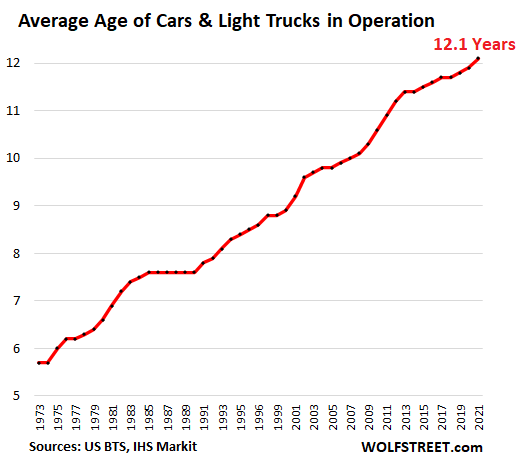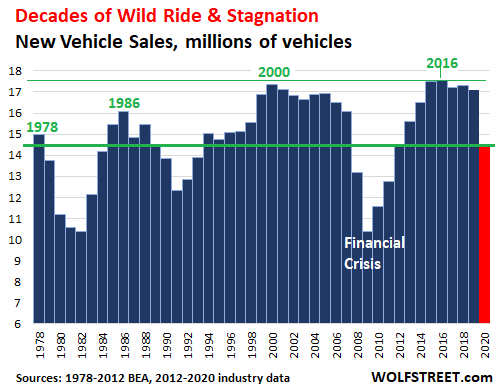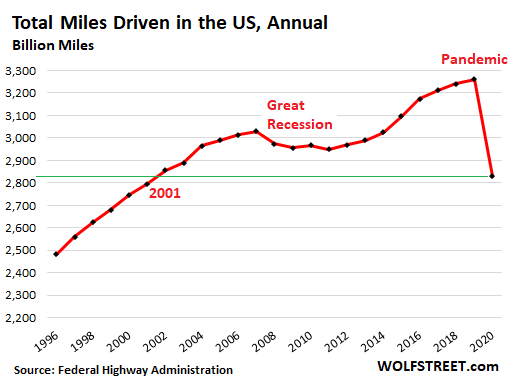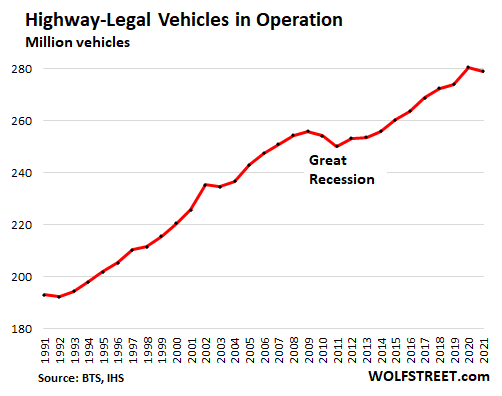June 14, 2021 | Average Age of Cars & Trucks on the Road Jumps to Record: The Circular Problem for Automakers

The average age of all cars and light trucks on the road in 2021 in the US, regardless of how many times they have been traded, jumped by about two months from last year, to a record of 12.1 years, according to IHS Markit today.
“Average age” means that a portion of the vehicles are removed from the national fleet at a much younger age, either because they were scrapped following an accident or natural disaster; or because they were exported as used vehicles. It also means that a portion of the vehicles on the road are far older, with a good bunch in their high teens or older that, with proper TLC, are still running fine.

One reason for the rise in the average age of vehicles over the decades is the improved durability of vehicles, foisted upon automakers by finicky Americans in an ultra-competitive market where slipshod quality and inadequate durability can doom automakers – or at least crush sales for years. Improving durability is a factor every year in the growing average age.
But for 2021, there has been the additional factor that also played a large role following the Financial Crisis: The 14% plunged in new vehicle sales last year reduced the number of new vehicles entering the national fleet and thereby pushed up the average age:

As the chart shows, new vehicle sales have been a very tough business in terms of volume: They have essentially stagnated for over two decades, interrupted only by deep plunges.
One of the reasons for this stagnation in vehicle unit sales despite a growing population is that vehicles last longer and remain in good shape longer and need to be replaced less often, and so the average age of vehicles on the road keeps getting longer.
The sharp decline in miles driven last year and early this year, as tracked by the Federal Highway Administration, may have been an additional factor in the increased average age of vehicles on the road, by possibly having delayed the exit of some of the oldest vehicles from the fleet, and by having also contributed to the drop in new vehicle sales last year.

The number of highway-legal vehicles in operation – passenger vehicles, buses, motorcycles, medium-duty trucks, and heavy trucks – dipped 0.5% as of January 2021, to 279 million vehicles, according to IHS today.
During the Great Recession, the number of vehicles in operation declined for two years in a row (-0.7% and -1.6%); and they declined following the 2002 recession (-0.3%), according to BTS data:

By the end of 2020, nearly 1 million EVs were registered, according to IHS. Interesting tidbit: More owners hang on to their EVs, than owners of vehicles with internal combustion engines. Of the 2016 through 2020 model-year EVs, 89% are still registered by their first owner, compared to only 68% of ICE vehicles of the same model years.
The average age of vehicles in operation has bedeviled auto makers and dealers for decades. Back in 1985, when I was just starting in the business, there was already a lot of fretting over the rising age of vehicles. This was a trend that could not last and it would have to revert to some kind of mean – that was the thinking. At the time, the average age was 7.8 years. It never reverted to any kind of mean and now reached 12.1 years.
An eight-year-old vehicle in 1985, with normal miles, was quite old and worn out. But those eight-year old vehicles were holding up still better than the ‘68 Mustang I bought in 1976. Things were falling off, ranging from the clutch linkage to the armrest, not to speak of the carburetor that was leaking gasoline, the doors that were leaking water when it was raining, the speedometer that had stopped working before I’d bought the car, the vinyl upholstery that was split open on the driver’s seat….
These are just some of the things I remember. I loved that car, it was my first car, it was only eight years old, it had a 289 V-8, no A/C, a 3-speed manual, and no power anything, and it was a piece of junk by today’s quality standards. It was the worst car I ever owned as all vehicles since then got consecutively better each time. When I traded in my car last year that I’d bought new 14 years earlier, it had 160,000 miles on it, still looked good, and ran without problems.
This phenomenon is a circular problem for the industry. Americans demand vehicles that last longer and wear out more slowly and look good longer; and automakers are competing with each other to produce those vehicles in order to stay relevant. But this is increasing the average age of vehicles on the road, which is curtailing sales of new vehicles.
And the only thing left for the auto industry to grow is to raise prices and shift consumers into more expensive models, which further curtails sales of new vehicles because a decreasing percentage of people can afford to buy them new at these prices – and they don’t have to because there are lots of eight-year-old and older vehicles out there that are in great shape that they can afford.
STAY INFORMED! Receive our Weekly Recap of thought provoking articles, podcasts, and radio delivered to your inbox for FREE! Sign up here for the HoweStreet.com Weekly Recap.
Wolf Richter June 14th, 2021
Posted In: Wolf Street











